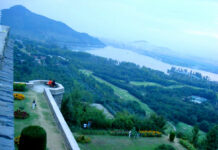Floods are a reality in Kashmir now. Let’s accept this fact. But by accepting this fact it doesn’t mean that we should simply acknowledge it and sit ducks. Rather we should take it as a cue to overhaul over existing disaster management system so that we are prepared to face any eventuality. There is a need to learn some quick lessons else we would end up getting caught unaware all the time. But were we caught unaware this time? No. There was clear warning from MeT department that for next seven days there is going to be moderate to heavy rainfall in Kashmir. And the warning itself was clear message for state administration that please pull yourself together and be ready. But did they get ready on time? No. The entire administration waited for some diving miracle and heavenly intervention to change the overcast. But it did not change, and instead it started to rain like it had never rained before. And within a day’s time it was hard to differentiate between Dal Lake and Lal Chowk. The Bakshi era drainage system failed to contain the amount of rainfall that has accumulated by now. It was Sunday and the entire Lal Chowk area was gripped by panic. People were emptying their shops to avoid September 2014 like situation. And that was the time when state government swung into action and started charting out plans for a possible mass evacuation. But by then things were already out of control as sixteen members belonging to two different families have lost their lives in remote Laden village.
Ideally September 2014, floods should have been taken as a wake-up call by the state administration to get things on track and be prepared for any such situation. But instead of drafting a fool proof disaster management policy state administration went into relax mode after the great floods. They did not even bother to repair the washed out bunds. And after six months those weak bunds came back to haunt locals once again. These six months should have been utilized by the administration to fast track the repair and reconstruction work of important points along Jhelum. But unfortunately nothing of that sorts happened. There were just half-hearted attempts to fix these dykes that too on a snail’s pace. After September 2014 floods, the flow of Jhelum was at its lowest thus giving administration enough time to dredge that river so that its retaining capacity is increased. But first elections then government formation put things out of gear. And the focus got entirely shifted. Politics shadowed everything else and administration conveniently slept over the clear and present danger. Let us hope that the second wake-up call, from Mother Nature, in a span of just six months would shake the state administration out of its slumber.
Else all we are left with is just action reaction kind of response to save our lives!









